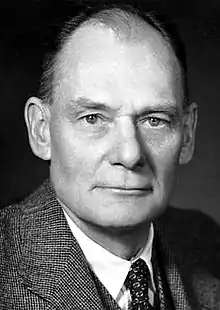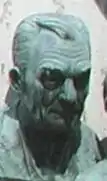John Franklin Enders
John Franklin Enders (February 10, 1897 – September 8, 1985) was an American biomedical scientist and Nobel Laureate. Enders has been called "The Father of Modern Vaccines."[1][2]
John Franklin Enders | |
|---|---|
 | |
| Born | February 10, 1897 |
| Died | September 8, 1985 (aged 88) |
| Nationality | American |
| Education | St. Paul's School |
| Alma mater | Yale University Harvard University |
| Known for | culturing poliovirus, isolating measlesvirus, developing measles vaccine |
| Awards | Albert Lasker Award for Basic Medical Research (1954) Nobel Prize in Physiology or Medicine (1954) Cameron Prize for Therapeutics of the University of Edinburgh (1960) |
Life and education
Enders was born in West Hartford, Connecticut. His father, John Ostrom Enders, was CEO of the Hartford National Bank and left him a fortune of $19 million upon his death. He attended the Noah Webster School in Hartford, and St. Paul's School in Concord, New Hampshire. After attending Yale University a short time, he joined the United States Army Air Corps in 1918 as a flight instructor and a lieutenant.
After returning from World War I, he graduated from Yale, where he was a member of Scroll and Key as well as Delta Kappa Epsilon. He went into real estate in 1922, and tried several careers before choosing the biomedical field with a focus on infectious diseases, gaining a Ph.D. at Harvard in 1930. He later joined the faculty at Children's Hospital Boston.[3]
Enders died in 1985 in Waterford, Connecticut, aged 88, holding honorary doctoral degrees from 13 universities.[4] His wife died in 2000.
Biomedical career
In 1949, Enders, Thomas Huckle Weller, and Frederick Chapman Robbins reported successful in vitro culture of an animal virus—poliovirus.[5] The three received the 1954 Nobel Prize in Physiology or Medicine "for their discovery of the ability of polioviruses to grow in cultures of various types of tissue".
Meanwhile, Jonas Salk applied the Enders-Weller-Robbins technique to produce large quantities of poliovirus, and then developed a polio vaccine in 1952. Upon the 1954 polio vaccine field trial, whose success Salk announced on the radio,[6] Salk became a public hero but failed to credit the many other researchers that his effort rode upon, and was somewhat shunned by America's scientific establishment.[7]
In 1954, Enders and Peebles isolated measlesvirus from an 11-year-old boy, David Edmonston.[8] Disappointed by polio vaccine's development and involvement in some cases of polio and death—what Enders attributed to Salk's technique—Enders began development of measles vaccine.[8] In October 1960, an Enders team began trials on 1,500 mentally retarded children in New York City and on 4,000 children in Nigeria.[9]
On September 17, 1961, The New York Times announced the measles vaccine effective.[9] Refusing credit for only himself, Enders stressed the collaborative nature of the effort.[9] In 1963, Pfizer introduced a deactivated measles vaccine, and Merck & Co introduced an attenuated measles vaccine.
Honors

- 1946: Fellow of the American Academy of Arts and Sciences[10]
- 1954: Nobel Prize in Physiology or Medicine (together with Frederick Chapman Robbins and Thomas Huckle Weller)[11][12]
- 1955: Kyle Award from the U.S. Public Health Service[13]
- 1958: inducted into the Polio Hall of Fame
- 1960: Cameron Prize for Therapeutics of the University of Edinburgh
- 1962: Robert Koch Prize
- 1963: Presidential Medal of Freedom
- 1963: Science Achievement Award from the American Medical Association
- 1967: Foreign Member, The Royal Society[1]
See also
References
- Tyrrell, D. A. J. (1987). "John Franklin Enders. 10 February 1897-8 September 1985". Biographical Memoirs of Fellows of the Royal Society. 33: 212–226. doi:10.1098/rsbm.1987.0008. JSTOR 769951. PMID 11621434.
- Katz SL (2009). "John F. Enders and measles virus vaccine—a reminiscence". Measles. Current Topics in Microbiology and Immunology. 329. pp. 3–11. doi:10.1007/978-3-540-70523-9_1. ISBN 978-3-540-70522-2. PMID 19198559.
- "John F. Enders - Biographical". Nobelprize.org. Nobel Media. 2014. Retrieved 7 February 2017.
- Thomas H Weller & Frederick C Robb, A Biographical Memoir: John Franklin Enders (1897–1985), (Washington DC: National Academy of Sciences, 1991), p 62.
- Enders JF, Weller TH, Robbins FC (1949). "Cultivation of the Lansing strain of poliomyelitis virus in cultures of various human embryonic tissues". Science. 109 (2822): 85–87. Bibcode:1949Sci...109...85E. doi:10.1126/science.109.2822.85. PMID 17794160.
- "Salk announces polio vaccine" Archived 2010-02-11 at the Wayback Machine. History.com. 2010. Retrieved 31 Jan 2010.
- Balik R, "On this day: Polio vaccine declared safe", FindingDulcinea, 12 Apr 2011.
- Baker JP (2011). "The first measles vaccine". Pediatrics. 128 (3): 435–7. doi:10.1542/peds.2011-1430. PMID 21873696.
- Bakalar N, "First mention: Measles vaccine, 1960", New York Times, 5 Oct 2010, p D2.
- "Book of Members, 1780–2010: Chapter A" (PDF). American Academy of Arts and Sciences. Retrieved 15 Apr 2011.
- "How a CT man who majored in English at Yale became the 'Father of Modern Vaccines'". CTInsider.com. 2020-09-08. Retrieved 2020-09-19.
- October 2019, Live Science Staff 07. "Nobel Prize in Medicine: 1901-Present". livescience.com. Retrieved 2020-09-19.
- "Enders, John F. (1897-1985) | Encyclopedia.com". www.encyclopedia.com. Retrieved 2020-09-19.
- Oakes, Elizabeth H. (2007). Encyclopedia of World Scientists. New York: Facts on File.
- Tyrrell, D. A. J. (1987). Biographical Memoirs of Fellows of the Royal Society Vol. 33. The Royal Society.
External links
- John F. Enders on Nobelprize.org
 including the Nobel Lecture, December 11, 1954 The Cultivation of the Poliomyelitis Viruses in Tissue Culture
including the Nobel Lecture, December 11, 1954 The Cultivation of the Poliomyelitis Viruses in Tissue Culture - John Franklin Enders Papers (MS 1478). Manuscripts and Archives, Yale University Library.
